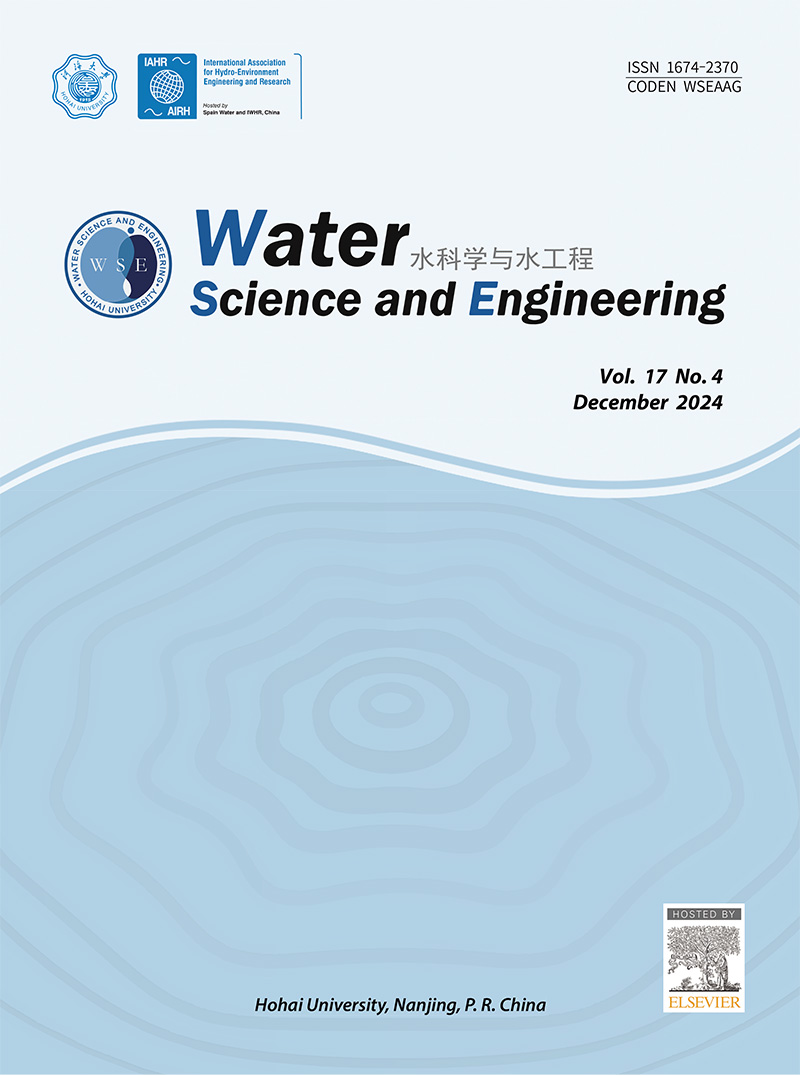基于统计模型的新型嵌入式混合tio2 -渣催化剂异质结纳米复合材料光催化净化含染料废水:可持续和技术经济途径
IF 4.3
Q1 WATER RESOURCES
引用次数: 0
摘要
钢铁工业产生许多副产品,需要大量土地来储存,并造成严重的环境污染。排入水体的工业废水对水生生态系统和人类健康都产生负面影响。为了解决这一问题,本研究以1:2的质量比合成了二氧化钛(TiO2)和钢渣纳米复合材料(SSNC)的复合材料,制备了一种鲁棒的光催化剂,用于处理合成废水。在模拟太阳光照条件下测试了该催化剂对亚甲基蓝(MB)等多种染料污染物的降解效果。对复合材料的物理化学特性、晶体结构、能隙和零电荷点进行了综合分析。TiO2-SSNC复合催化剂具有良好的稳定性,其零电荷点为8.342,能隙为2.4 eV。降解过程符合准一级动力学。通过响应面法对操作参数进行了优化。重复使用试验表明,经过5次循环后,TiO2-SSNC复合催化剂在悬浮模式下可有效降解MB达93.41%,在涂层模式下可有效降解MB达92.03%。此外,对各种染料的降解效率显著,突出了复合材料在工业废水处理中的广泛应用潜力。本研究还探索了降解机制,鉴定了副产物,建立了污染物分解的途径。成本效益分析显示,每次处理活动的总成本为0.842 8美元/立方米,表明运营和生产成本较低。这些发现强调了二氧化钛- ssnc复合材料作为一种经济高效的废水净化替代品的前景。本文章由计算机程序翻译,如有差异,请以英文原文为准。
Photocatalytic purification of dye-containing wastewater using a novel embedded hybrid TiO2–slag catalyst heterojunction nanocomposite coupled with statistical models: A sustainable and techno-economic approach
The steel industry produces many byproducts, requiring extensive land for storage and causing significant environmental contamination. Industrial effluents discharged into water bodies negatively impact both aquatic ecosystems and human health. To solve this problem, this study synthesized a composite of titanium dioxide (TiO2) and steel slag nanocomposites (SSNC) at a 1:2 mass ratio to create a robust photocatalyst for the treatment of synthetic wastewater. The efficacy of this catalyst in degrading various dye pollutants, including methylene blue (MB), was tested under simulated solar light conditions. Comprehensive analyses were conducted to assess the physical and chemical characteristics, crystalline structure, energy gap, and point of zero charge of the composite. The TiO2-SSNC composite catalyst exhibited excellent stability, with a point of zero charge at 8.342 and an energy gap of 2.4 eV. The degradation process conformed to pseudo-first-order kinetics. Optimization of operational parameters was achieved through the response surface methodology. Reusability tests demonstrated that the TiO2-SSNC composite catalyst effectively degraded up to 93.41% of MB in the suspended mode and 92.03% in the coated mode after five cycles. Additionally, the degradation efficiencies for various dyes were significant, highlighting the potential of the composite for broad applications in industrial wastewater treatment. This study also explored the degradation mechanisms and identified byproducts, establishing a pathway for contaminant breakdown. The cost-benefit analysis revealed a total cost of 0.842 8 USD per cubic meter for each treatment activity, indicating low operational and production costs. These findings underscore the promise of the TiO2-SSNC composite as a cost-effective and efficient alternative for wastewater purification.
求助全文
通过发布文献求助,成功后即可免费获取论文全文。
去求助
来源期刊

Water science and engineering
WATER RESOURCES-
CiteScore
6.60
自引率
5.00%
发文量
573
审稿时长
50 weeks
期刊介绍:
Water Science and Engineering journal is an international, peer-reviewed research publication covering new concepts, theories, methods, and techniques related to water issues. The journal aims to publish research that helps advance the theoretical and practical understanding of water resources, aquatic environment, aquatic ecology, and water engineering, with emphases placed on the innovation and applicability of science and technology in large-scale hydropower project construction, large river and lake regulation, inter-basin water transfer, hydroelectric energy development, ecological restoration, the development of new materials, and sustainable utilization of water resources.
 求助内容:
求助内容: 应助结果提醒方式:
应助结果提醒方式:


